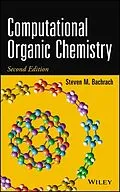The Second Edition demonstrates how computational chemistry continues to shed new light on organic chemistry
The Second Edition of author Steven Bachrach's highly acclaimed Computational Organic Chemistry reflects the tremendous advances in computational methods since the publication of the First Edition, explaining how these advances have shaped our current understanding of organic chemistry. Readers familiar with the First Edition will discover new and revised material in all chapters, including new case studies and examples. There's also a new chapter dedicated to computational enzymology that demonstrates how principles of quantum mechanics applied to organic reactions can be extended to biological systems.
Computational Organic Chemistry covers a broad range of problems and challenges in organic chemistry where computational chemistry has played a significant role in developing new theories or where it has provided additional evidence to support experimentally derived insights. Readers do not have to be experts in quantum mechanics. The first chapter of the book introduces all of the major theoretical concepts and definitions of quantum mechanics followed by a chapter dedicated to computed spectral properties and structure identification. Next, the book covers:
- Fundamentals of organic chemistry
- Pericyclic reactions
- Diradicals and carbenes
- Organic reactions of anions
- Solution-phase organic chemistry
- Organic reaction dynamics
The final chapter offers new computational approaches to understand enzymes. The book features interviews with preeminent computational chemists, underscoring the role of collaboration in developing new science. Three of these interviews are new to this edition.
Readers interested in exploring individual topics in greater depth should turn to the book's ancillary website www.comporgchem.com, which offers updates and supporting information. Plus, every cited article that is available in electronic form is listed with a link to the article.
Autorentext
STEVEN M. BACHRACH is the Dr. D. R. Semmes Distinguished Professor of Chemistry at Trinity University. Dr. Bachrach has published some 125 articles. With the support of the National Science Foundation and the Welch Foundation, he researches computational approaches to build our understanding of nucleophilic substitution reactions and the role of solvents.
Inhalt
Preface xv
Acknowledgments xxi
1. Quantum Mechanics for Organic Chemistry 1
1.1 Approximations to the Schrödinger EquationThe HartreeFock Method 2
1.1.1 Nonrelativistic Mechanics 2
1.1.2 The BornOppenheimer Approximation 3
1.1.3 The One-Electron Wavefunction and the HartreeFock Method 3
1.1.4 Linear Combination of Atomic Orbitals (LCAO) Approximation 4
1.1.5 HartreeFockRoothaan Procedure 5
1.1.6 Restricted Versus Unrestricted Wavefunctions 7
1.1.7 The Variational Principle 7
1.1.8 Basis Sets 8
1.1.8.1 Basis Set Superposition Error 12
1.2 Electron CorrelationPost-HartreeFock Methods 13
1.2.1 Configuration Interaction (CI) 14
1.2.2 Size Consistency 16
1.2.3 Perturbation Theory 16
1.2.4 Coupled-Cluster Theory 17
1.2.5 Multiconfiguration SCF (MCSCF) Theory and Complete Active Space SCF (CASSCF) Theory 18
1.2.6 Composite Energy Methods 20
1.3 Density Functional Theory (DFT) 22
1.3.1 The Exchange-Correlation Functionals: Climbing Jacob's Ladder 24
1.3.1.1 Double Hybrid Functionals 26
1.3.2 Dispersion-Corrected DFT 26
1.3.3 Functional Selection 28
1.4 Computational Approaches to Solvation 28
1.4.1 Microsolvation 28
1.4.2 Implicit Solvent Models 29
1.4.3 Hybrid Solvation Models 34
1.5 Hybrid QM/MM Methods 35
1.5.1 Molecular Mechanics 36
1.5.2 QM/MM Theory 38
1.5.3 ONIOM 39
1.6 Potential Energy Surfaces 40
1.6.1 Geometry Optimization 42
1.7 Population Analysis 45
1.7.1 Orbital-Based Population Methods 46
1.7.2 Topological Electron Density Analysis 47
1.8 Interview: Stefan Grimme 48
References 51
2. Computed Spectral Properties and Structure Identification 61
2.1 Computed Bond Lengths and Angles 61
2.2 IR Spectroscopy 62
2.3 Nuclear Magnetic Resonance 66
2.3.1 General Considerations 68
2.3.2 Scaling Chemical Shift Values 69
2.3.3 Customized Density Functionals and Basis Sets 71
2.3.4 Methods for Structure Prediction 73
2.3.5 Statistical Approaches to Computed Chemical Shifts 74
2.3.6 Computed Coupling Constants 76
2.3.7 Case Studies 77
2.3.7.1 Hexacyclinol 77
2.3.7.2 Maitotoxin 79
2.3.7.3 Vannusal B 80
2.3.7.4 Conicasterol F 81
2.3.7.5 1-Adamantyl Cation 81
2.4 Optical Rotation, Optical Rotatory Dispersion, Electronic Circular Dichroism, and Vibrational Circular Dichroism 82
2.4.1 Case Studies 85
2.4.1.1 Solvent Effect 85
2.4.1.2 Chiral Solvent Imprinting 86
2.4.1.3 Plumericin and Prismatomerin 87
2.4.1.4 2,3-Hexadiene 88
2.4.1.5 Multilayered Paracyclophane 89
2.4.1.6 Optical Activity of an Octaphyrin 90
2.5 Interview: Jonathan Goodman 90
References 93
3. Fundamentals of Organic Chemistry 99
3.1 Bond Dissociation Enthalpy 99
3.1.1 Case Study of BDE: Trends in the RX BDE 102
3.2 Acidity 104
3.2.1 Case Studies of Acidity 107
3.2.1.1 Carbon Acidity of Strained Hydrocarbons 107
3.2.1.2 Origin of the Acidity of Carboxylic Acids 113
3.2.1.3 Acidity of the Amino Acids 116
3.3 Isomerism and Problems With DFT 119
3.3.1 Conformational Isomerism 119
3.3.2 Conformations of Amino Acids 121
3.3.3 Alkane Isomerism and DFT Errors 123
3.3.3.1 Chemical Consequences of Dispersion 131
3.4 Ring Strain Energy 132
3.4.1 RSE of Cyclopropane (28) and Cylcobutane (29) 138
3.5 Aromaticity 144
3.5.1 Aromatic Stabilization Energy (ASE) 145
3.5.2 Nucleus-Independent Chemical Shift (NICS) 150
3.5.3 Case Studies of Aromatic Compounds 155
3.5.3.1 [n]An...
